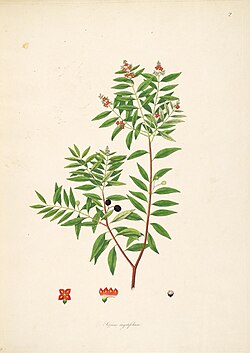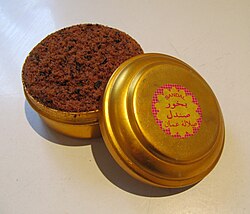Santalum album
Santalum album L.
| Ordre | Santalales |
|---|---|
| Famille | Santalaceae |
| Genre | Santalum |
2n =
Origine : aire d'origine
sauvage ou cultivé
| Français | santal |
|---|---|
| Anglais | sandalwood |
- plante à parfum
- bois d'œuvre
Description
-
arbre
-
1, port ; 2, rameau en fleurs ; 3, fleur ; 4, fruit (PROSEA).
-
rameau en fleurs
-
fruit
Noms populaires
| français | santal, santal blanc |
| anglais | sandalwood, Indian sandalwood, fragrant sandalwood, white sandalwood |
| allemand | Sandelholzbaum |
| néerlandais | sandelhout |
| italien | sandalo citrino |
| espagnol | sándalo |
| portugais | sândalo |
| arabe | صندل - ṣandal |
| persan | صندل - ṣandal |
| chinois | (Flora of China) |
| sanscrit | अनिंदिता - anindita, arishta-phalam, bhadrasara, चन्दनम् - chandanam (Flowers of India) ; chandana, amaditam, taliaparnam (Wealth of India) |
| hindi | चंदन - chandan, संदल - sandal (Flowers of India) ; safed chandan (Wealth of India) |
| ourdou | sandal safaid (Flowers of India) |
| bengali | চংদন্ - chandan, শ্ৱেতচংদন - shwetchandan (Flowers of India) ; peetchandan, srikhanda, sufaid chandan (Wealth of India) |
| marathi | चंदन - chandan, gandhachakoda (Flowers of India) |
| gujerati | sukhad, sukhet (Wealth of India) |
| konkani | sriganda (Wealth of India) |
| telugu | bhadrasri, చందనమ్ - chandanamu (Flowers of India) ; chandanapuchettu, tellagandhapu-chettu (arbre), gandhataruvu (arbre), srigandhamu, gandhapu-chekka (bois) (Wealth of India) |
| tamoul | anukkam, asam, சந்தநம் - chandanam (Flowers of India) ; sandanam, ulocidam, kulavuri (Wealth of India) |
| kannada | ಚಂದನ - chandana, ಗಂಧ - gandha, ಶ್ರೀಗಂಧ - srigandha, bavanna, ಭದ್ರಶ್ರೀ - bhadrasri, ಪಟೇರ - patera (Flowers of India) ; agarugandha, bhandrasri (Wealth of India) |
| malayalam | ചംദനമ് - chandanam, chandana-mutti (Flowers of India) |
| odia | valgaka (Flowers of India) ; chondono, gondassaro (Wealth of India) |
| manipuri | চংদন - chandan (Flowers of India) |
| népalais | श्रीखण्ड - shreekhand (Flowers of India) |
| punjabi | chandan |
| Indonésie | cendana (général), ai nitu (Sumba), hau meni (Timor) (PROSEA) |
| Malaysia | chendana (PROSEA) |
| Thaïlande | chantana (PROSEA) |
| Birmanie | san-ta-ku (PROSEA) |
- Voir la notice du Trésor de la langue française informatisé
Classification
Santalum album L. (1753)
Cultivars
Histoire
-
catu-tsjambu vol. 4 pl. 8 Rheede 1683
-
Roxburgh, 1795, Plants of the coast of Coromandel, vol. 1, pl. 6
-
Albrecht, 1804, Icones plantarum medico-oeconomico-technologicarum, pl. 180
-
Köhler, 1897. Medizinal-Pflanzen
-
timbre d'Indonésie (2009)
Usages
-
sculpture de Ganesh
-
statue à Pondichéry (Inde)
-
poudre de santal vendu à Oman
Native probably in SE Indonesia, however since long times naturalized in India, Sri Lanka, S China, other parts of Indonesia, N Australia. In India, SE Asia, China and Australia cultivated. The species is succesfully introduced into Tanzania, Nigeria, Fiji, Hawaii and to other countries, SE Asia and India being the most important producers. The culture of the semiparasite is difficult, because host plants are needed. About 500 potential host plants are known, among them remarkably many herbaceous species. For sandal cultivation Cassia siamea has been favoured in general. The hardwood is white or lemon-coloured, rarely reddish and very fragrant (yellow sandalwood). It is used variously for cabinetry and is highly esteemed in the Orient. The distillation of the hardwood yields the East Indian Sandalwood oil (Oleum santali). It is officinal but the main use is in the production of Oriental perfumes. It is also utilised in the production of cosmetics like soaps, powder, creams. Indian literature mentioned Santalum album earliest circa 500 BC (Nirukta) and 400-300 BC (Anjuttara, Vinya Pitaka), but probably sandalwood was utilized long before in religious ceremonies. It became an essential part of Brahmin, Buddhist and other religious rituals. Incense was also closely connected with Hindi erotic arts. Sandalwood and its products were brought eastwards to China and incorporated into almost every parts of daily life. Arabian and Persian merchants brought sandalwood westwards. - In Europe it was first mentioned in the first cent. AD, and then AD 545 by Cosmos Indicopleustes of Alexandria. Domestication and first production of Sandelwood Oil took place obviously in India, using stills imported by Arabian merchants. Breeding progress achieves strains with a better yield of oil and resistance against spike disease, which heavily effects the cultivation of sandalwood tree and the sandalwood industry.











